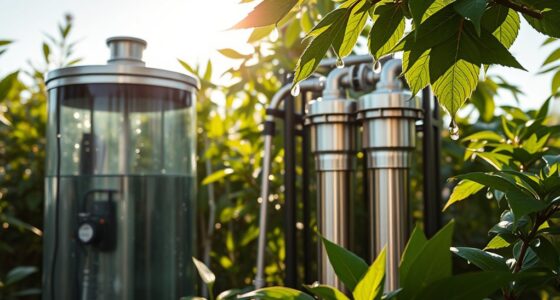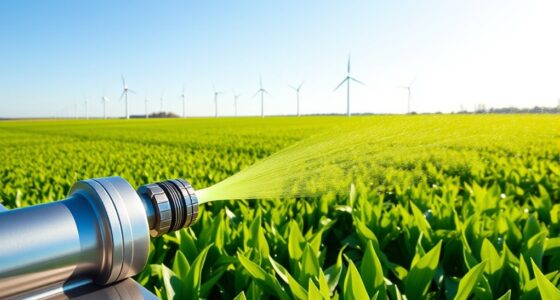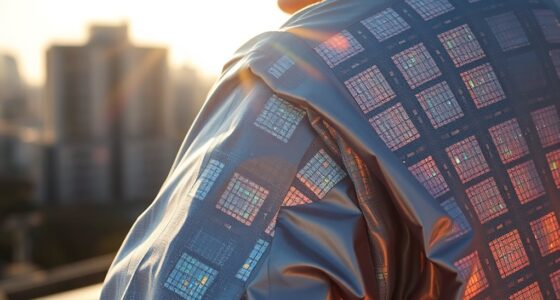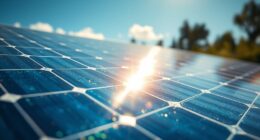Eco-concrete is designed to actively promote coral and marine life growth in harbors by integrating a special admixture that encourages biological settlement. Its textured, reef-like surfaces mimic natural environments, helping corals and other organisms establish quickly. The material also fosters biodiversity and creates habitats that strengthen structures while reducing maintenance needs. Additionally, eco-concrete’s eco-friendly formulas sequester carbon, making it sustainable. To discover how this innovative approach can transform harbor ecosystems, keep exploring the details.
Key Takeaways
- ECOncrete incorporates a proprietary admixture that promotes coral settlement and growth on harbor structures.
- Its textured, reef-like surfaces mimic natural habitats, encouraging coral attachment and development.
- Biolayer formation enhances calcitic organism growth, supporting reef-building and coral ecosystem restoration.
- The ecological concrete reduces environmental impact while fostering biodiversity and coral proliferation.
- Its durable, bioprotective features sustain long-term coral growth in harsh marine harbor conditions.

In an innovative leap for marine infrastructure, eco-concrete now encourages the growth of corals and other marine life directly on harbor structures. This cutting-edge material, known as ECOncrete, incorporates a proprietary admixture that makes it uniquely suitable for supporting marine ecosystems. By adding just 10% of this admixture to the cementitious mix, you create a concrete that actively promotes the settlement and growth of oysters, corals, and tubeworms. Unlike traditional concrete, which is inert and often harmful to marine life, ECOncrete’s chemistry encourages calcitic organisms to form a biolayer called bioprotection. This layer acts as a natural buffer against chemical and hydrodynamic forces, shielding the structure from weathering and erosion. Additionally, ECOncrete’s composition reduces permeability and increases resistance to chloride ions, markedly boosting durability in harsh marine conditions. Supports up to 2X more biodiversity compared to traditional concrete structures. You’ll find that the biological growth on ECOncrete structures acts like a natural “biological glue,” enhancing the strength and longevity of the infrastructure. The surface texture and mold designs are carefully crafted to create complex ecological niches, mimicking natural reef environments and supporting diverse marine species. These textured surfaces foster rapid colonization by algae, plants, and calcareous organisms, which are essential for reef development and biodiversity. This biological activity also produces a bioprotective layer, which diminishes the impact of weathering and hydrodynamic forces, further extending the lifespan of your marine infrastructure. The ecological benefits of the material are complemented by its ability to reduce the overall environmental footprint of construction projects. Beyond structural benefits, ECOncrete offers notable environmental advantages. When combined with supplementary cementitious materials like slag cement or fly ash, it achieves up to 70% lower embodied carbon than traditional concrete. Importantly, ECOncrete can biologically sequester carbon after installation, making it a post-installation carbon sink. For example, a one-kilometer seawall built with ECOncrete can sequester the equivalent of 100 mature trees’ annual carbon intake. This ability to absorb and store CO₂ helps mitigate climate change impacts, reducing the overall carbon footprint of marine construction projects. The surface design, made possible through advanced mold-modifying agents and liners, creates complex 3D textured surfaces that resemble natural reefs. These surfaces promote rapid settlement of marine organisms and support coral growth by providing suitable, biocompatible environments. As a result, ECOncrete not only strengthens harbor structures but also actively restores and enhances marine ecosystems. Its combination of innovative chemistry, textured surfaces, and ecological functionality makes ECOncrete a transformative solution for sustainable, resilient, and environmentally friendly marine infrastructure.
Frequently Asked Questions
How Long Does It Take for Coral to Fully Colonize Eco-Concrete?
You’re wondering how long it takes for coral to fully colonize eco-concrete. Typically, coral begins attaching and growing within the first few months, with significant coverage often visible after one year. While initial colonization can be delayed by high pH levels during curing, this doesn’t affect long-term growth. Most species establish well within a year, and with continued development, ecological communities flourish over several years.
Can Eco-Concrete Be Used in Deep-Sea Harbor Environments?
You ask if eco-concrete can be used in deep-sea harbor environments. The answer is yes. Eco-concrete is specifically designed for versatile marine infrastructure, including deep-water settings. Its chemical composition and surface texture promote marine life growth, even under harsh conditions. It meets industry standards for strength and durability, resists corrosion, and supports biodiversity. Using eco-concrete in deep-sea harbors helps improve water quality and encourages the growth of native marine species, making it an ideal choice.
What Is the Cost Difference Between Eco-Concrete and Traditional Concrete?
The current question asks about the cost difference between eco-concrete and traditional concrete. You’ll find that eco-concrete generally costs 20–24% more per cubic yard, mainly due to proprietary materials and production methods. However, this higher initial cost can be offset by lifecycle savings, like reduced foundation and structural costs, especially in lightweight variants. Still, coral-growing eco-concrete is experimental, so exact costs are not yet established.
How Does Eco-Concrete Impact Local Marine Ecosystems?
You might wonder how eco-concrete affects local marine ecosystems. It acts as a natural habitat, supporting coral attachment and growth, which boosts biodiversity. It encourages marine life like oysters, macroalgae, and fish, helping rebuild reef structures. Additionally, eco-concrete sequesters carbon, improves water quality, and enhances ecosystem resilience. By promoting healthy marine habitats, you help restore balance and support thriving, sustainable coastal environments.
Is Eco-Concrete Resistant to Harsh Weather Conditions and Storms?
Imagine your home standing strong through a fierce storm—that’s how eco-concrete resists harsh weather. Studies show eco-concretes survive up to 300 freeze-thaw cycles with minimal damage, much like a sturdy ship weathering rough seas. While high temperatures and moisture pose risks, with proper admixtures and curing, eco-concrete can endure storms, high winds, and flooding, making it a resilient choice for long-lasting, durable structures in extreme conditions.
Conclusion
As you see how eco-concrete can help grow coral naturally, it’s a reminder that sometimes, nature finds its way, even in unexpected places. Just like how this innovation appears right where it’s needed, it shows that solutions often emerge when we least expect them. By supporting such technologies, you’re not just protecting harbors—you’re helping nature reclaim its space, proving that sometimes, the most remarkable growth happens where we least anticipate.










